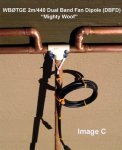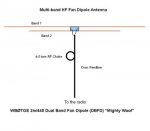Ok, let me drawl on something about antennas. There's nothing magical about them, just plain physics.
You have a handheld with a rubber duck antenna. Convenient and portable yes. The best to use, no. The best way to describe a rubber duck would be a negative gain antenna. Some are good, others are just horrible. Building an external antenna can increase your signal output. The easiest thing to build is a dipole (as shown above) or a quarter wave ground plane and normally referred to as a unity gain antenna. Just using that will help your signal out by a minimal amount even though it would be close to the handheld inside.
These are easy to build and if you stick to published dimensions it should be in the ball park without any fancy testing.
Now what if you want an antenna that gives you a little gain. Agreed this will help, but building it becomes more complicated and you really don't know if it's tuned and preforming correctly unless you invest in some kind of test gear that would tell what it's actually doing. And for what? Maybe an omni antenna that would give you 2.5, 3, maybe 5dB if you're lucky. If you're into this this, go for it. Experiment and try different things. That's what this is all about. If it doesn't work out, toss it into the bone yard and try something different.
Now take that same unity gain antenna (1/4 wave ground plane or dipole) that is easy to build and you know it otta work, stick it outside on a pole maybe 15 or 20 foot up in the air with some good quality coax and I couldn't see why you wouldn't see a 5 to 10dB increase in signal strength over your rubber duck. Easy to do for increased coverage. That's what I'd do.
After that, then you could think about that high gain co-linear antenna you're going to build on that 75 foot tower you just set up in the back yard.




